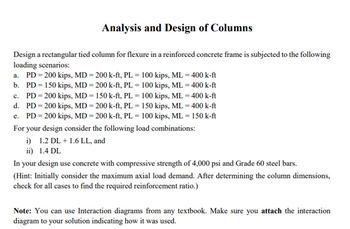
Structural Analysis
6th Edition
ISBN: 9781337630931
Author: KASSIMALI, Aslam.
Publisher: Cengage,
expand_more
expand_more
format_list_bulleted
Concept explainers
Question

Transcribed Image Text:Analysis and Design of Columns
Design a rectangular tied column for flexure in a reinforced concrete frame is subjected to the following
loading scenarios:
a. PD = 200 kips, MD = 200 k-ft, PL = 100 kips, ML = 400 k-ft
b.
PD = 150 kips, MD = 200 k-ft, PL = 100 kips, ML = 400 k-ft
c. PD = 200 kips, MD = 150 k-ft, PL = 100 kips, ML = 400 k-ft
PD = 200 kips, MD = 200 k-ft, PL = 150 kips, ML = 400 k-ft
d.
e. PD = 200 kips, MD = 200 k-ft, PL = 100 kips, ML = 150 k-ft
For your design consider the following load combinations:
i) 1.2 DL + 1.6 LL, and
ii) 1.4 DL
In your design use concrete with compressive strength of 4,000 psi and Grade 60 steel bars.
(Hint: Initially consider the maximum axial load demand. After determining the column dimensions,
check for all cases to find the required reinforcement ratio.)
Note: You can use Interaction diagrams from any textbook. Make sure you attach the interaction
diagram to your solution indicating how it was used.
Expert Solution
This question has been solved!
Explore an expertly crafted, step-by-step solution for a thorough understanding of key concepts.
This is a popular solution
Trending nowThis is a popular solution!
Step by stepSolved in 5 steps with 2 images

Follow-up Questions
Read through expert solutions to related follow-up questions below.
Follow-up Question
How did you come up with the size of the rectangular cross section b = 16 inches and h = 24 inches in step 3 of this solution?
Solution
by Bartleby Expert
Follow-up Question
Does the solution for part a really end once the sketch for the tied column is drawn. Dont you have to check for the minimum width of the cross section?
Solution
by Bartleby Expert
Follow-up Questions
Read through expert solutions to related follow-up questions below.
Follow-up Question
How did you come up with the size of the rectangular cross section b = 16 inches and h = 24 inches in step 3 of this solution?
Solution
by Bartleby Expert
Follow-up Question
Does the solution for part a really end once the sketch for the tied column is drawn. Dont you have to check for the minimum width of the cross section?
Solution
by Bartleby Expert
Knowledge Booster
Learn more about
Need a deep-dive on the concept behind this application? Look no further. Learn more about this topic, civil-engineering and related others by exploring similar questions and additional content below.Similar questions
- The beam shown below is subjected to a uniform live load, ωL = 1k/ft. In addition, the beam must resist a superimposed dead load, ωD.S = 0.8k/ft as well as its self-weight. The concrete strength is 6,000 psi and the steel is Grade 60. The beam is not in contact with the ground or exposed to weather (hint: cover). Calculate the nominal and design shear strengths of the beam section. Is the beam shear design adequate? If so, redesign the beam to make the design more economical. If not, redesign the beam for shear to ensure the design is adequate per ACI 318-19 standards. . The beam shown below is subjected to a uniform live load, ωL = 1k/ft. In addition, the beam must resist a superimposed dead load, ωD.S = 0.8k/ft as well as its self-weight. The concrete strength is 6,000 psi and the steel is Grade 60. The beam is not in contact with the ground or exposed to weather (hint: cover). Calculate the nominal and design shear strengths of the beam section. Is the beam shear designadequate? If…arrow_forwarda) Write and explain one advantage and onedisadvantage of using intermediate stiffeners in plate girders. b) If a plate girder design was initially determined to require intermediate stiffeners, but one optedtonot use them, how else could the plate girder be designed to achieve the same shaer capacity. c) A w-shepe beam is bent in bi-axial bending. All loading passes through its shear center. Please explain why the flexural strenght about its weak axis is the fullplastic moment capacity regardless of Lbarrow_forwardThe service load bending moments on a beam are 128 kip-ft for dead load and 107 kip-ft for live load. The beam is 12 in. wide, f'c is 3000 psi and fy is 60 ksi. Determine Mu. Mt. p. R. the depth of the beam and the As of tensile reinforcing required. How many no. 8 bars or No. 10 bars would have the required As?arrow_forward
Recommended textbooks for you

 Structural Analysis (10th Edition)Civil EngineeringISBN:9780134610672Author:Russell C. HibbelerPublisher:PEARSON
Structural Analysis (10th Edition)Civil EngineeringISBN:9780134610672Author:Russell C. HibbelerPublisher:PEARSON Principles of Foundation Engineering (MindTap Cou...Civil EngineeringISBN:9781337705028Author:Braja M. Das, Nagaratnam SivakuganPublisher:Cengage Learning
Principles of Foundation Engineering (MindTap Cou...Civil EngineeringISBN:9781337705028Author:Braja M. Das, Nagaratnam SivakuganPublisher:Cengage Learning Fundamentals of Structural AnalysisCivil EngineeringISBN:9780073398006Author:Kenneth M. Leet Emeritus, Chia-Ming Uang, Joel LanningPublisher:McGraw-Hill Education
Fundamentals of Structural AnalysisCivil EngineeringISBN:9780073398006Author:Kenneth M. Leet Emeritus, Chia-Ming Uang, Joel LanningPublisher:McGraw-Hill Education
 Traffic and Highway EngineeringCivil EngineeringISBN:9781305156241Author:Garber, Nicholas J.Publisher:Cengage Learning
Traffic and Highway EngineeringCivil EngineeringISBN:9781305156241Author:Garber, Nicholas J.Publisher:Cengage Learning


Structural Analysis (10th Edition)
Civil Engineering
ISBN:9780134610672
Author:Russell C. Hibbeler
Publisher:PEARSON

Principles of Foundation Engineering (MindTap Cou...
Civil Engineering
ISBN:9781337705028
Author:Braja M. Das, Nagaratnam Sivakugan
Publisher:Cengage Learning

Fundamentals of Structural Analysis
Civil Engineering
ISBN:9780073398006
Author:Kenneth M. Leet Emeritus, Chia-Ming Uang, Joel Lanning
Publisher:McGraw-Hill Education


Traffic and Highway Engineering
Civil Engineering
ISBN:9781305156241
Author:Garber, Nicholas J.
Publisher:Cengage Learning